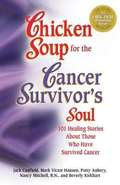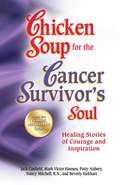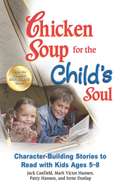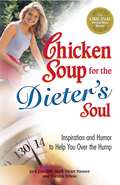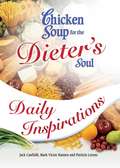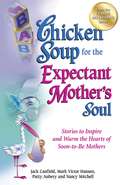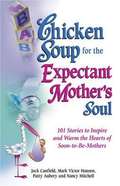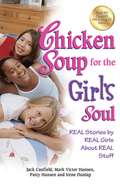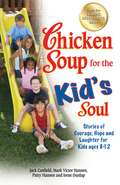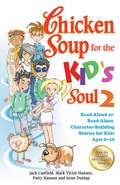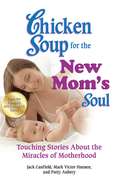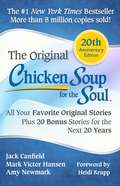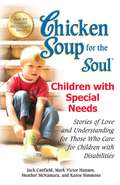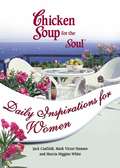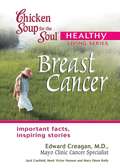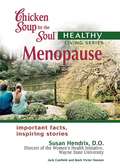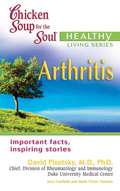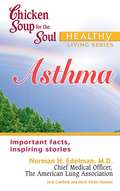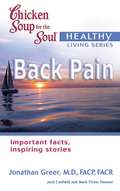- Table View
- List View
Chicken Soup for the Cancer Survivor's Soul: 101 Stories of Courage and Inspiration from Those Who Have Survived Cancer
by Jack Canfield Mark Victor Hansen Patty Aubery Nancy MitchellMore than 100 cancer survivors share their personal stories in this touching new collection of Chicken Soup. These heartwarming accounts of courageous people who found the power to battle cancer in their endless hope, unwavering faith and steadfast determination will inspire you to adopt a positive attitude, discover your faith and cherish every moment. Just what the doctor ordered for healing your body, mind and soul.
Chicken Soup for the Cancer Survivor's Soul: Healing Stories of Courage and Inspiration
by Jack Canfield Mark Victor Hansen Patty Aubery Nancy Mitchell R. N Beverly KirkhartMore than 100 cancer survivors share their personal stories in this touching new collection of Chicken Soup. These heartwarming accounts of courageous people who found the power to battle cancer in their endless hope, unwavering faith, and steadfast determination will inspire you to adopt a positive attitude, discover your faith, and cherish every moment. Just what the doctor ordered for healing your body, mind, and soul.
Chicken Soup for the Child's Soul
by Jack Canfield Mark Victor Hansen Patty Hansen Irene DunlapToday's children live in a world filled with adventure, mental stimulation, topical issues, and personal challenges. The values they learn now, between the ages of 5 and 8, will shape the rest of their lives. Through this collection of heartfelt true stories about family ties, helping neighbors, and lasting friendships, children will see how other kids their age have learned valuable lessons from the choices they've made--and most of all, they will realize that they are not alone in dealing with some of the difficult issues in their lives; such as the loss of a loved one, accepting and respecting others, taking responsibility for their actions, coping with fitting in, or learning to make friends. Chicken Soup for the Child's Soul is a book that can help guide children as they explore their relationships with peers and family members, and begin to develop their own personal values. You and your children will share special times reading these real-life stories to each other, as together you explore how other children have dealt with everyday issues in healthy, positive ways. Reading Child's Soul stories together can serve as an entrance to conversations about the topics of the stories, which can create better family and classroom communication during these exciting years of growth.
Chicken Soup for the Christian Soul: Open the Heart and Rekindle the Spirit
by Jack Canfield Mark Victor Hansen Patty Aubery Nancy MitchellFrom the Book Jacket: "What an awesome celebration of God's love for each of his children! Read Chicken Soup for the Christian Soul anytime, but especially when you need a heavenly hug." Joan Wester Anderson author, Where Angels Walk and Where Wonders Prevail "'God created man/" someone once suggested, 'because he liked stories.' When Jesus spoke, he spoke most often in parables. This collection continues the tradition of faithful people telling stories of their experience of God met in the routine of life. I laughed and cried as I read them. In story after story I recognized the thread of divinity woven into the fabric of life. A treasure for Christians who love to hear and tell stories." Michael Lindvall author, The Good News from North Haven "Your walk with Christ will be enhanced every single day as you open the pages of this spirit-filled book." Glenna Salsbury professional speaker, author, The Art of the Fresh Start
Chicken Soup for the Dieter's Soul
by Jack Canfield Mark Victor Hansen Theresa PelusoThe Inspiration You Need to Make Healthy Habits Stick--for Life Monday is for dieting. Tuesday is for cravings. Wednesday is for getting on the scale. And Thursday is for reflecting. Between struggling with cravings, deciphering nutrition labels, facing the scale, controlling portions, and setting realistic goals, it's no wonder most diets fail . . . until now. With a dose of Chicken Soup (low-fat, of course!), you can: · Control cravings· Get back on track after straying· Eat out--and enjoy it· Set--and achieve--your weight-loss goals With tips, motivational messages, and an exercise, food, and mood tracking system, Chicken Soup for the Dieter's Soul Daily Inspirations will help you tackle the issues on the way to a healthier you.
Chicken Soup for the Dieter's Soul Daily Inspirations
by Jack Canfield Mark Victor Hansen Patricia LorenzThe Inspiration You Need to Make Healthy Habits Stick--for Life Monday is for dieting. Tuesday is for cravings. Wednesday is for getting on the scale. And Thursday is for reflecting. Between struggling with cravings, deciphering nutrition labels, facing the scale, controlling portions, and setting realistic goals, it's no wonder most diets fail . . . until now. With a dose of Chicken Soup (low-fat, of course!), you can: · Control cravings· Get back on track after straying· Eat out--and enjoy it· Set--and achieve--your weight-loss goals With tips, motivational messages, and an exercise, food, and mood tracking system, Chicken Soup for the Dieter's Soul Daily Inspirations will help you tackle the issues on the way to a healthier you.
Chicken Soup for the Dieter's Soul Daily Inspirations
by Jack Canfield Mark Victor Hansen Patricia LorenzThe Inspiration You Need to Make Healthy Habits Stick--for Life Monday is for dieting. Tuesday is for cravings. Wednesday is for getting on the scale. And Thursday is for reflecting. Between struggling with cravings, deciphering nutrition labels, facing the scale, controlling portions, and setting realistic goals, it's no wonder most diets fail . . . until now. With a dose of Chicken Soup (low-fat, of course!), you can: · Control cravings · Get back on track after straying · Eat out--and enjoy it · Set--and achieve--your weight-loss goals With tips, motivational messages, and an exercise, food, and mood tracking system, Chicken Soup for the Dieter's Soul Daily Inspirations will help you tackle the issues on the way to a healthier you.
Chicken Soup for the Dieter's Soul: Inspiration and Humor to Help You Over the Hump
by Jack Canfield Mark Victor Hansen Theresa PelusoThe Inspiration You Need to Make Healthy Habits Stick--for Life Monday is for dieting. Tuesday is for cravings. Wednesday is for getting on the scale. And Thursday is for reflecting. Between struggling with cravings, deciphering nutrition labels, facing the scale, controlling portions, and setting realistic goals, it's no wonder most diets fail . . . until now. With a dose of Chicken Soup (low-fat, of course!), you can: · Control cravings · Get back on track after straying · Eat out--and enjoy it · Set--and achieve--your weight-loss goals With tips, motivational messages, and an exercise, food, and mood tracking system, Chicken Soup for the Dieter's Soul Daily Inspirations will help you tackle the issues on the way to a healthier you.
Chicken Soup for the Expectant Mother's Soul
by Jack Canfield Mark Victor Hansen Patty Aubery Nancy MitchellEvery year, millions of women wait with anticipation as they watch their test strip change from white to pink, thus beginning the awesome adventure of becoming a mother. This Chicken Soup book will find a place in the loving hearts and anxious minds of expectant mothers (and some fathers, too!). Written by expectant mothers, veteran moms, and fathers-to-be, these stories relate the physical, emotional, and spiritual joys and challenges of each stage of motherhood, from "barely showing" to the awkward last months, from labor and delivery to watching and caring for Baby.Some stories offer hope when the pregnancy isn't medically perfect; others offer light-hearted humor to cope with weight gain, morning sickness, and other pregnancy woes; and still others offer words of wisdom for the seemingly daunting responsibilities of choosing a name, going through labor, and bringing a new life into the world. By relaying the insecurities and triumphs of a variety of moms and moms-to-be--including multiple births, premature births, adoptions, and single-parent families--this book will tug at the heartstrings and ease the fears of any expectant mother, regardless of her situation. Chapters include: Special Moments, Delivery Day, Challenges, On Adoption, Advice from Others, For Expectant Fathers, and The First Few Years. Chicken Soup for the Expectant Mother's Soul will be a must-have on every baby-shower gift list, and an essential requirement for every birthing bag.
Chicken Soup for the Expectant Mother's Soul: 101 Stories to Inspire and Warm the Hearts of Soon-to-Be Mothers
by Mark Victor Hansen Patty Aubery Nancy Mitchell Jack L. CanfieldStories to inspire and encourage mothers-to-be.
Chicken Soup for the Expectant Mother's Soul: Stories to Inspire and Warm the Hearts of Soon-to-Be Mothers
by Jack Canfield Mark Victor Hansen Patty Aubery Nancy MitchellEvery year, millions of women wait with anticipation as they watch their test strip change from white to pink, thus beginning the awesome adventure of becoming a mother. This Chicken Soup book will find a place in the loving hearts and anxious minds of expectant mothers (and some fathers, too!). Written by expectant mothers, veteran moms, and fathers-to-be, these stories relate the physical, emotional, and spiritual joys and challenges of each stage of motherhood, from "barely showing" to the awkward last months, from labor and delivery to watching and caring for Baby. Some stories offer hope when the pregnancy isn't medically perfect; others offer light-hearted humor to cope with weight gain, morning sickness, and other pregnancy woes; and still others offer words of wisdom for the seemingly daunting responsibilities of choosing a name, going through labor, and bringing a new life into the world. By relaying the insecurities and triumphs of a variety of moms and moms-to-be--including multiple births, premature births, adoptions, and single-parent families--this book will tug at the heartstrings and ease the fears of any expectant mother, regardless of her situation. Chapters include: Special Moments, Delivery Day, Challenges, On Adoption, Advice from Others, For Expectant Fathers, and The First Few Years. Chicken Soup for the Expectant Mother's Soul will be a must-have on every baby-shower gift list, and an essential requirement for every birthing bag.
Chicken Soup for the Girl's Soul
by Jack Canfield Mark Victor Hansen Patty Hansen Irene DunlapFrom Barbies to your first bra, from holding your teddy bear to slow-dancing with your first boyfriend, from knowing everyone in elementary school to trying to make new friends in middle school. . . . When dealing with these changes, it's no wonder preteen girls can freak out from time to time. Consider Chicken Soup for the Girl's Soul your survival guide! From reading the true experiences of other preteen girls, as well as women who've been there, you'll see that you're not the only one who feels clueless and insecure sometimes. You'll read about tough subjects, such as peer pressure, cliques, divorce, and loss, as well as fun "girls only" stories about friendship, embarrassing moments (these could take up an entire book!), body changes, and first crushes. These stories will make you laugh, cry, and realize that girl power is truly something to celebrate. You'll turn to this book again and again, whenever you need the advice only girls can give. Chicken Soup for the Girl's Soul is sure to be what a girl wants!
Chicken Soup for the Kid's Soul
by Jack Canfield Mark Victor Hansen Patty Hansen Irene DunlapToday's kids face grave issues and harder decisions than ever before. Gang warfare, violence, drugs, alcohol, smoking, pregnancy, depression, and suicide have found their way into middle and elementary schools. Divorce splits apart families every day. These issues make kids feel as if they must understand and accept all the troubles of the world. Now more than ever, kids want and need the inspiration and hope that Chicken Soup for the Soul provides. In this special volume, young readers will find empowerment and encouragement to love and accept themselves, believe in their dreams, find answers to their questions, and discover hope for a promising future.
Chicken Soup for the Kid's Soul 2
by Jack Canfield Mark Victor Hansen Patty Hansen Irene DunlapThis book, designed for kids ages six to ten, features true, character-building stories for kids to enjoy alone or with their parents. Being a kid can be trying and confusing--a newfound exposure to the real world, confusion as to what's right and wrong, learning about friendships and making important choices for the first time. Chicken Soup for the Kid's Soul 2 is a special book designed just for kids on the verge of becoming preteens. Written by kids and adults reminiscing about their childhood, this book features true stories that exemplify character-building traits such as acceptance, honesty, kindness, responsibility, forgiveness, bravery, and perseverance. It also features larger, reader-friendly type and custom-created cartoon strips featuring "The Souper Kids" cartoon characters.
Chicken Soup for the New Mom's Soul
by Jack Canfield Mark Victor Hansen Patty AuberyChicken Soup for the New Mom's Soul is a collection of stories from the hearts of mothers, old and new, about the most amazing and profound experience in a woman's life--the birth of her first child. It's a time of fear, excitement, and exhilaration. Inside this book, you'll read about the unique love, the unbreakable bond, and unforgettable moments between mother and child; the pride and joy in seeing your child's first smile, hearing his first word, and the long-awaited milestones like sleeping through the night and potty training. The stories in this book allow you to revel not just in your own experiences but in those who have gone before you. Laugh out loud, be inspired, and gain a sense of confidence as you read these amazing stories. Most important, discover that you are not alone in your journey through motherhood "firsts." As you read this collection of poignant, silly, and even embarrassing stories, you will gain the courage and strength in knowing that you are a wonderful mother.
Chicken Soup for the Soul 20th Anniversary Edition
by Mark Victor Hansen Amy Newmark Mark Victor Amy Hansen Canfield Jack Newmark Heidi KruppThe twentieth anniversary edition of the original Chicken Soup for the Soul is brimming with even more hope and inspiration--the stories you've always loved, plus bonus stories! Twenty years later, Chicken Soup for the Soul continues to open the heart and rekindle the spirit. Celebrate the twentieth anniversary with the classic book that inspired millions--reinvigorated with bonus stories of inspiration! You will find hope and inspiration in these 101 heartwarming stories about counting your blessings, thinking positive, and overcoming challenges.
Chicken Soup for the Soul Children with Special Needs
by Jack Canfield Mark Victor Hansen Heather Mcnamara Karen SimmonsRaising a child with special needs is a lifelong commitment that is as unique as each person who embarks on it. Written by a variety of authors who share in this distinctive relationship, Chicken Soup for the Soul Children with Special Needs offers a glimpse into the lives of others who are on a similar path. These stories provide insight, comfort, and connection with others who have walked this powerful and transformational journey. The authors of these candid stories relate their own experiences of adjusting, reaching out, and flourishing and share their universal worries, their tears, and the laughter that come with this extraordinary relationship. Most important, through these stories, you will be guided with the wisdom of fellow parents, caregivers, and those with special needs to help you be the very best parent or caregiver you can be.
Chicken Soup for the Soul Daily Inspirations for Women
by Jack Canfield Mark Victor Hansen Marcia Higgins WhiteChicken Soup hits the daily inspiration market with bite-sized stories to start every day of the year off right. What woman doesn't need a dose of inspiration? These one-page entries are not lessons like a typical affirmation book, but complete mini-stories that capture the magic and wonder of Chicken Soup. The book features 365 stories, as well as affirmations, quotes, and inspirational messages, that will stay with you throughout the day and prompts to fill in your own daily thoughts.
Chicken Soup for the Soul Healthy Living Series Brest Cancer: Important Facts, Inspiring Stories
by Jack Canfield Mark Victor Hansen Mary Olsen Kelly Edward CreaganThis new series from Chicken Soup for the Soul--inspirational stories followed by positive, practical medical advice for caregivers and patients--is the perfect blend of emotional support and vital information on breast cancer, including: * understanding your diagnosis * working with your doctor * talking with friends and family * treatment options * from baldness to breastforms * emotional healing * conquering side effects * alternative therapies * finding support groups * thriving with breast cancer Chicken Soup for the Soul partners with top doctors to give you the information you need to survive--and the positive inspiration to thrive. Each book features beautifully written stories, plus information on diet, lifestyle, diagnosis, procedures, caregiving, emotional issues, and alternative therapies from some of the world's foremost experts.
Chicken Soup for the Soul Healthy Living Series Menopause: Important Facts, Inspiring Stories
by Jack Canfield Mark Victor Hansen Susan HendrixThis new series from Chicken Soup for the Soul--inspirational stories followed by positive, practical medical advice for caregivers and patients--is the perfect blend of emotional support and vital information about menopause including: · common myths · unknown facts · talking with friends and family · from mood swings to "mentalpause" · relieving symptoms · spicing up your life · the truth about HRT · alternative treatments · taking charge of your health · the positive side of menopause Chicken Soup for the Soul partners with top doctors to give you the information you need to survive--and the positive inspiration to thrive. Each book features beautifully written stories plus information on diet, lifestyle, diagnosis, procedures, caregiving, emotional issues, and alternative therapies from some of the world's foremost experts.
Chicken Soup for the Soul Healthy Living Series Stress: important facts, inspiring storie
by Jack Canfield Mark Victor Hansen Leslie GodwinThis book on stress in the successful Chicken Soup for the Soul Healthy Living Series offers inspirational stories followed by positive, practical advice.
Chicken Soup for the Soul Healthy Living Series: Arthritis
by Jack Canfield Mark Victor Hansen M.D. David PisetskyThis new book in the successful Healthy Living series--inspirational stories followed by positive, practical medical advice for caregivers and patients--addresses an issue that is endemic among older Americans. The good news is that we are living longer; the bad news is that many aging people are living with some type of pain. In fact, 66 million people (nearly 1 in 3 adults) have doctor-diagnosed arthritis; 23.2 million people are living with chronic joint pain. Here is a book to offer them information and inspiration in an easy-to-read, trusted formula. In the Healthy Living series, Chicken Soup for the Soul partners with the nation's top medical experts and organizations to give emotional support and important information to people with specific medical needs. The books feature approximately twelve positive, heartwarming stories from real people, followed by relevant expert medical advice that will positively impact the reader's life. Subjects such as diet, psychological issues, family relations, and alternative therapies exist side-by-side with traditional subjects such as understanding common medical terms, the effects of treatment options, and the doctor-patient relationship. Each book contains source notes and a resources section for more information and support.
Chicken Soup for the Soul Healthy Living Series: Asthma
by Jack Canfield Mark Victor Hansen Norman H. EdelmanAsthma is a chronic condition that affects all areas of your life--or even worse, those of your children's. This book shows you how to prevent asthma flare-ups, support loved ones, and not let this condition negatively affect your activities, your goals, or your psychological approach to life. In the Healthy Living series, Chicken Soup for the Soul partners with the nation's top medical experts and organizations to give emotional support and important information to people with specific medical needs. The books feature approximately twelve positive, heartwarming stories from real people, followed by relevant expert medical advice that will positively impact the reader's life. Subjects such as diet, psychological issues, family relations, and alternative therapies exist side-by-side with traditional subjects such as understanding common medical terms, the effects of treatment options, and the doctor-patient relationship. Each book contains source notes and a resources section for more information and support.
Chicken Soup for the Soul Healthy Living Series: Back Pain
by Jack Canfield Mark Victor Hansen Jonathan GreerChicken Soup for the Soul joins forces with top doctors to give you the cutting-edge medical information you need and the positive inspiration to thrive. Each book features true stories from other patients plus information on diet, lifestyle adjustments, diagnosis, medical tests, and procedures, along with caregiving and emotional issues from the medical sector's most informed experts.
Chicken Soup for the Soul Healthy Living Series: Breast Cancer
by Jack Canfield Mark Victor Hansen Mary Olsen Kelly Dr Edward CreaganThis new series from Chicken Soup for the Soul--inspirational stories followed by positive, practical medical advice for caregivers and patients--is the perfect blend of emotional support and vital information on breast cancer, including:* understanding your diagnosis* working with your doctor* talking with friends and family* treatment options* from baldness to breastforms* emotional healing* conquering side effects* alternative therapies* finding support groups* thriving with breast cancerChicken Soup for the Soul partners with top doctors to give you the information you need to survive--and the positive inspiration to thrive. Each book features beautifully written stories, plus information on diet, lifestyle, diagnosis, procedures, caregiving, emotional issues, and alternative therapies from some of the world's foremost experts.
